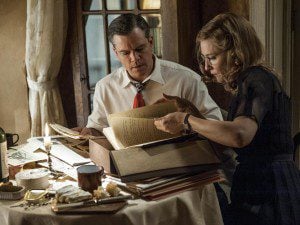 Sixteen years ago, Matt Damon starred in Saving Private Ryan, a World War II movie that raised the question of whether it made sense for several solders to risk their lives just to save one ordinary man. Now he’s starring in The Monuments Men, a World War II movie about a bunch of soldiers who risk their lives — and, who knows, maybe the lives of others — to save classic works of art. And a question I’ve been wondering lately is whether the new film will even raise the question of whether it makes sense to sacrifice human life for inanimate objects of this sort.
Sixteen years ago, Matt Damon starred in Saving Private Ryan, a World War II movie that raised the question of whether it made sense for several solders to risk their lives just to save one ordinary man. Now he’s starring in The Monuments Men, a World War II movie about a bunch of soldiers who risk their lives — and, who knows, maybe the lives of others — to save classic works of art. And a question I’ve been wondering lately is whether the new film will even raise the question of whether it makes sense to sacrifice human life for inanimate objects of this sort.
The question isn’t really raised in any of the film’s promotional videos, which spell out the heroism of the main characters and the justification for their cause. As Damon puts it in the featurette below: “Ultimately, it’s a movie about people who are willing to sacrifice everything to save what is the very best of us, of humanity.”
Now don’t get me wrong. I love cultural treasures as much as the next person, and it pains me to see any work of art destroyed — an emotion I sometimes have to overcome when deciding which of my children’s many sketches to save for posterity and which to toss in the recycling bin. (We simply can’t keep them all.)
And yet, there is something about this film that is beginning to remind me of a scene from Woody Allen’s Bullets over Broadway (1994), in which a pompous playwright played by Rob Reiner asks his friends, “Let’s say there was a burning building, and you could rush in and you could save only one thing: either the last known copy of Shakespeare’s plays or some anonymous human being. What would you do?”
The Reiner character would clearly prefer to save the collection of plays — on the basis that “It’s not an inanimate object! It’s art! Art is life! It lives!”, a line he delivers immediately after the clip above comes to an end — but this scene takes place within a film that ultimately says human beings are more important than works of art.
(Consider also Woody Allen’s famous quip: “I don’t want to achieve immortality through my work. I want to achieve it through not dying.”)
Of course, the fact that works of art and other objects can outlive human beings sometimes grants them a special significance, in the eyes of some people, and this is doubly true for artifacts that are imbued with some sort of religious meaning. And sometimes even those who don’t subscribe to a sacramental view of the world can still feel stirrings of the grace that is mediated through works of religious art.
So it’s not too surprising that the Monuments Men featurette above includes a brief exchange between one of the title characters and some priests as they move certain works of art to safety: “Are you a Catholic, lieutenant?” “I am tonight.”
Anyway. One of the things I liked about Saving Private Ryan was, as I put it in one of my reviews, the fact that it “lays out the basic conflict at the heart of all warfare, namely, the tension between the value of individual human beings and the tendency of armies everywhere to reduce their men to statistics,” and that it “gets us to think in clear, if contradictory, terms about this moral tension.”
It will be interesting to see if The Monuments Men encourages similar reflection — or if it simply takes for granted that the monuments need to outlive the men.
Update: Many thanks to Anna Bottinelli, a researcher for the Monuments Men Foundation, for tweeting me a link to this collection of movie-junket soundbites, in which George Clooney makes a distinction between saving or losing “a specific piece of art”, on the one hand, and saving an entire “culture”, on the other hand:
http://www.youtube.com/watch?v=jMWZpvpz2Ts
One question Clooney doesn’t address is how many specific works of art it would take to define a “culture”. If you wouldn’t die for one painting, would you die for two, or five, or ten? In its own way, this question is not unlike the question posed by Saving Private Ryan, which affirms the value of individual human beings but also explores the fact that, within war, soldiers are encouraged to think of each other not as individuals but as parts of a collective: enemy troops are not fellow human beings, but “the enemy”, while commanders are sometimes required to move their own troops into dangerous situations knowing that there will be heavy casualties.
The obvious difference, though, is that where the collective focus in regular warfare leads to destruction, in the form of soldiers killing each other etc., the collective focus of the “monuments men” led to the opposite of destruction, at least insofar as they were able to preserve art and culture. The question now, I guess, is how many human lives can justifiably be put at risk for how many specific pieces of art!













